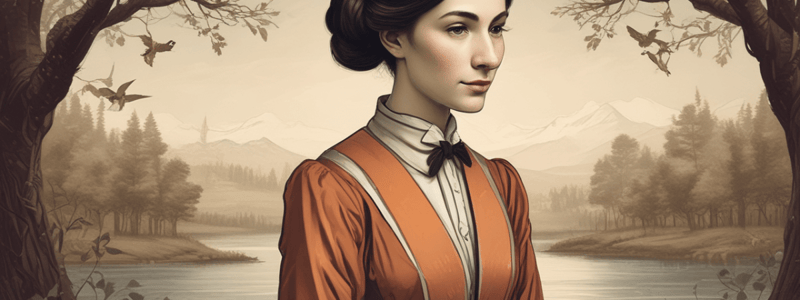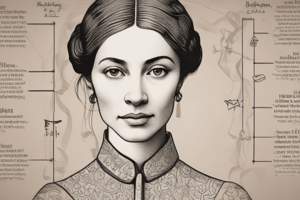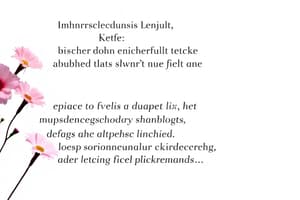Podcast
Questions and Answers
What is the main theme of the poem '“Hope” is the thing with feathers'?
What is the main theme of the poem '“Hope” is the thing with feathers'?
- The beauty of birdsong
- The power of hope to sustain us in troubled times (correct)
- The futility of human existence
- The destructive power of nature
What literary device is used to compare hope to a little bird?
What literary device is used to compare hope to a little bird?
- Personification
- Conceit (correct)
- Alliteration
- Metaphor
What is the effect of the repetition of 'that' and 'and' in the poem?
What is the effect of the repetition of 'that' and 'and' in the poem?
- It creates a sense of uncertainty
- It draws attention away from the subject of hope
- It slows down the pace of the poem
- It adds a sense of confidence and authority (correct)
What does the 'Gale' represent in the poem?
What does the 'Gale' represent in the poem?
What is the effect of the sibilance in the second stanza?
What is the effect of the sibilance in the second stanza?
What is the effect of the use of iambic trimeter in the poem?
What is the effect of the use of iambic trimeter in the poem?
In relation to hope, what is meant by the line "Yet, never, in Extremity, It asked a crumb – of me" in the final stanza of the poem
In relation to hope, what is meant by the line "Yet, never, in Extremity, It asked a crumb – of me" in the final stanza of the poem
What is the tone of the poem '“Hope” is the thing with feathers'?
What is the tone of the poem '“Hope” is the thing with feathers'?
What is the purpose of the bird metaphor in the poem?
What is the purpose of the bird metaphor in the poem?
What does the image of hope singing a song without words suggest?
What does the image of hope singing a song without words suggest?
What is the overall message of the poem?
What is the overall message of the poem?
Flashcards
Hope's Power
Hope's Power
Hope sustains us during difficult times, offering a constant source of strength.
Hope-Bird Metaphor
Hope-Bird Metaphor
Dickinson compares hope to a bird, symbolizing resilience and unwavering presence.
Univeral Hope
Univeral Hope
Hope is a shared human experience, connecting us all regardless of circumstance.
Hope in Struggle
Hope in Struggle
Signup and view all the flashcards
Hope's Selflessness
Hope's Selflessness
Signup and view all the flashcards
Iambic Trimeter
Iambic Trimeter
Signup and view all the flashcards
Conceit
Conceit
Signup and view all the flashcards
Study Notes
Poem Analysis: "Hope" is the thing with feathers
Themes and Ideas
- The poem explores the power of hope to sustain us in troubled times
- Hope is a universal concept that unites people
Style
- The poem uses a conceit, comparing hope to a little bird
- Anaphora is employed through the repetition of "that" and "and" throughout the stanzas
- Dickinson randomly capitalises certain words to add importance, such as "Hope", "Gale", "Bird", "Sea", and "Extremity"
- The poem follows an iambic trimeter rhythm, creating a steady and confident pace
Imagery and Symbolism
- The bird represents hope, singing a tune without words that is understood by everyone
- The gale symbolises the harsh external realities of life that necessitate hope
- The sea represents the extreme conditions in which hope is still present
Analysis of Key Quotes
- "Hope is the thing with feathers" - introduces the conceit of comparing hope to a bird
- "That perches in the soul - / And sings the tune without the words" - hope is a unifying force that resonates with everyone
- "And sweetest - in the Gale - is heard" - hope is most valuable in times of struggle
- "I've heard it in the chillest land - / And on the strangest Sea" - hope is present even in the most desperate situations
- "Yet, never, in Extremity, / It asked a crumb - of me" - hope never requires payment or thanks, it is selfless
Poem Analysis: "Hope" is the thing with feathers
Themes and Ideas
- The power of hope to sustain us in troubled times
- The universal nature of hope
Style
- Dickinson uses a conceit, comparing a little bird to the abstract idea of 'hope'
- Anaphora, repeating "that" and "and" throughout the stanzas, builds on the comparison
- Random capitalisation of words to add importance: "Hope", "Gale", "Bird", "Sea", "Extremity"
- Heavy use of iambic trimeter, creating a steady, confident rhythm
Key Quotes
- "Hope is the thing with feathers" - introducing the abstract concept of hope
- "That perches in the soul -" - hope is a unifying force
- "And sings the tune without the words -" - hope is understood by everyone, not limited by language
- "And never stops - at all -" - hope is constant and unwavering
Second Stanza
- Hope is "sweetest" when it is needed most, in times of struggle ("Gale")
- The use of "sweetest" conveys the highest form of praise for hope
- The metaphor of the "Gale" represents the harsh external realities of life
- Sibilance in the second stanza adds to the musical appeal, contrasting soft and harsh sounds
Third Stanza
- Dickinson claims to have "heard" hope "in the chilliest land - and on the strangest Sea -"
- Hope has never asked for payment or thanks, even in moments of despair
- "It asked a crumb - of me" - emphasising the selflessness of hope
- Dickinson highly values hope, especially when she needs it most
Studying That Suits You
Use AI to generate personalized quizzes and flashcards to suit your learning preferences.




